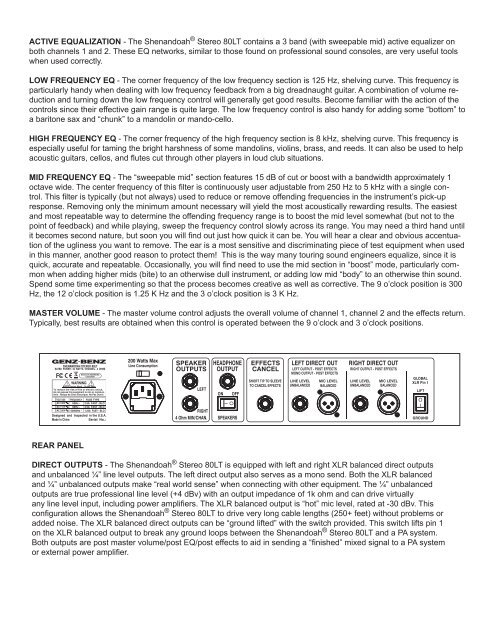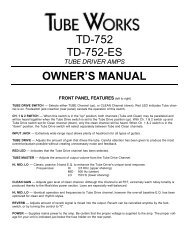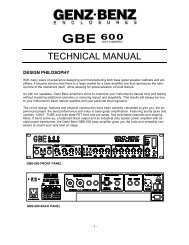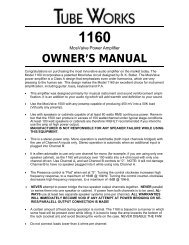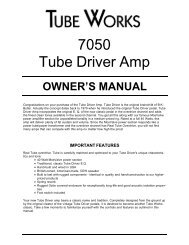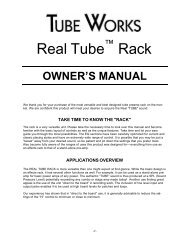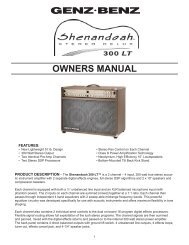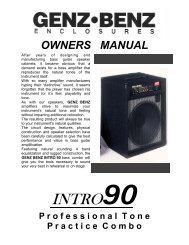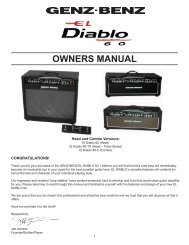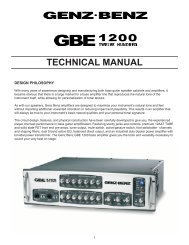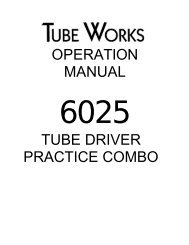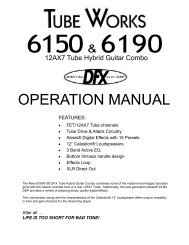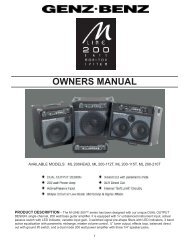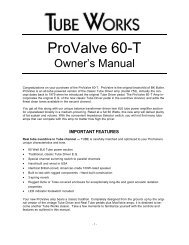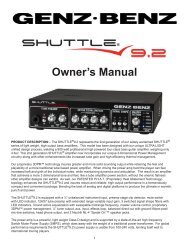Shenandoah 80LT Manual - Genz Benz
Shenandoah 80LT Manual - Genz Benz
Shenandoah 80LT Manual - Genz Benz
Create successful ePaper yourself
Turn your PDF publications into a flip-book with our unique Google optimized e-Paper software.
ACTIVE EQUALIZATION - The <strong>Shenandoah</strong> ® Stereo <strong>80LT</strong> contains a 3 band (with sweepable mid) active equalizer on<br />
both channels 1 and 2. These EQ networks, similar to those found on professional sound consoles, are very useful tools<br />
when used correctly.<br />
LOW FREQUENCY EQ - The corner frequency of the low frequency section is 125 Hz, shelving curve. This frequency is<br />
particularly handy when dealing with low frequency feedback from a big dreadnaught guitar. A combination of volume reduction<br />
and turning down the low frequency control will generally get good results. Become familiar with the action of the<br />
controls since their effective gain range is quite large. The low frequency control is also handy for adding some “bottom” to<br />
a baritone sax and “chunk” to a mandolin or mando-cello.<br />
HIGH FREQUENCY EQ - The corner frequency of the high frequency section is 8 kHz, shelving curve. This frequency is<br />
especially useful for taming the bright harshness of some mandolins, violins, brass, and reeds. It can also be used to help<br />
acoustic guitars, cellos, and flutes cut through other players in loud club situations.<br />
MID FREQUENCY EQ - The “sweepable mid” section features 15 dB of cut or boost with a bandwidth approximately 1<br />
octave wide. The center frequency of this filter is continuously user adjustable from 250 Hz to 5 kHz with a single control.<br />
This filter is typically (but not always) used to reduce or remove offending frequencies in the instrument’s pick-up<br />
response. Removing only the minimum amount necessary will yield the most acoustically rewarding results. The easiest<br />
and most repeatable way to determine the offending frequency range is to boost the mid level somewhat (but not to the<br />
point of feedback) and while playing, sweep the frequency control slowly across its range. You may need a third hand until<br />
it becomes second nature, but soon you will find out just how quick it can be. You will hear a clear and obvious accentuation<br />
of the ugliness you want to remove. The ear is a most sensitive and discriminating piece of test equipment when used<br />
in this manner, another good reason to protect them! This is the way many touring sound engineers equalize, since it is<br />
quick, accurate and repeatable. Occasionally, you will find need to use the mid section in “boost” mode, particularly common<br />
when adding higher mids (bite) to an otherwise dull instrument, or adding low mid “body” to an otherwise thin sound.<br />
Spend some time experimenting so that the process becomes creative as well as corrective. The 9 o’clock position is 300<br />
Hz, the 12 o’clock position is 1.25 K Hz and the 3 o’clock position is 3 K Hz.<br />
MASTER VOLUME - The master volume control adjusts the overall volume of channel 1, channel 2 and the effects return.<br />
Typically, best results are obtained when this control is operated between the 9 o’clock and 3 o’clock positions.<br />
REAR PANEL<br />
DIRECT OUTPUTS - The <strong>Shenandoah</strong> ® Stereo <strong>80LT</strong> is equipped with left and right XLR balanced direct outputs<br />
and unbalanced ¼” line level outputs. The left direct output also serves as a mono send. Both the XLR balanced<br />
and ¼” unbalanced outputs make “real world sense” when connecting with other equipment. The ¼” unbalanced<br />
outputs are true professional line level (+4 dBv) with an output impedance of 1k ohm and can drive virtually<br />
any line level input, including power amplifiers. The XLR balanced output is “hot” mic level, rated at -30 dBv. This<br />
configuration allows the <strong>Shenandoah</strong> ® Stereo <strong>80LT</strong> to drive very long cable lengths (250+ feet) without problems or<br />
added noise. The XLR balanced direct outputs can be “ground lifted” with the switch provided. This switch lifts pin 1<br />
on the XLR balanced output to break any ground loops between the <strong>Shenandoah</strong> ® Stereo <strong>80LT</strong> and a PA system.<br />
Both outputs are post master volume/post EQ/post effects to aid in sending a “finished” mixed signal to a PA system<br />
or external power amplifier.


